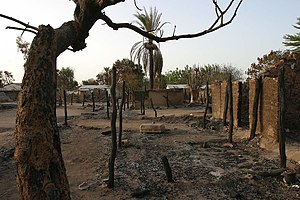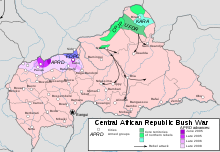The Central African Republic Bush War[5] was a civil war in the Central African Republic which lasted from 2004 to 2007 between Union of Democratic Forces for Unity (UFDR) rebels and government forces. The rebellion began after François Bozizé seized the nation's presidency in 2003. Actual fighting began in 2004.[6] Around 10,000 people were displaced because of the civil unrest.[1]
| Central African Republic Bush War | |||||||
|---|---|---|---|---|---|---|---|
 The town of Birao in northern CAR which was largely burnt down during the fighting in 2007 | |||||||
| |||||||
| Belligerents | |||||||
|
Rebels: ...and others
|
| ||||||
| Commanders and leaders | |||||||
|
Michel Djotodia (UFDR,[1] GAPLC[2]) Abakar Sabon (MLCJ)[2] Justin Hassane (FDC)[2] |
| ||||||
| Strength | |||||||
| 150+[citation needed] | 4,500+[citation needed] | ||||||
| Casualties and losses | |||||||
|
Civilian casualties: Hundreds killed, 212,000 displaced[4] | |||||||


The rebellion consisted of multiple rebel groups, several of which were of very small size and founded only towards the end of the conflict. Apart from the UFDR, the conflict included the People's Army for the Restoration of Democracy (CAR) (APRD), Groupe d'action patriotique pour la liberation de Centrafrique (GAPLC), the Movement of Central African Liberators for Justice (MLCJ), the Front démocratique Centrafricain (FDC), and Union of Republican Forces (UFR).[2]
A number of peace agreements have been signed to resolve the conflict between 2007 and 2012. The most important agreement, the Global Peace Accord (signed in Libreville, Gabon, on 21 June 2008), was first signed by the ARPD, UFDR, and FDPC groups. The agreement granted amnesty for any acts perpetrated against the state prior to the agreement, and called for a disarmament and demobilization process to integrate former rebels into society and the regular CAR armed forces.
Other rebel groups signed on to the agreement later, or signed similar agreements with the government (e.g. UFR on 15 December 2008). The only major group not to sign an agreement at the time was the CPJP, which continued its activities and signed a peace agreement with the government on 25 August 2012.[7]
Timeline
edit2004
editIn November 2004, at least 20 people were killed in a raid on the remote town of Birao in the north-east of the Central African Republic.[6]
2006
editThousands of people marched into the capital of the CAR, Bangui, on November 8, and pleaded for the government's troops to confront the UFDR.[8] Twenty members of the government were killed, and only three of the rebels died in this attack.
It was also confirmed that the UFDR had gained access to several armored vehicles, including a plane that landed in Birao earlier to bring supplies.[8]
On November 13, 2006, a third town in northern CAR, Sam Ouandja, was seized by the UFDR.[9] Just three days later, claims stated that a fourth town, Ouadda, had been captured by the rebels. When the 20,000 residents of the city heard that the UFDR was going to capture the town, between 5,000 and 10,000 of those people fled, mostly to the neighboring cities of Bambari and Bangui.[10]
The UFDR were reportedly planning to take over the city of Bria, though rumours also supported that an additional attack may occur in Ndele.[8] In December 2006, Chadian troops in three army trucks attacked Bémal, located next to Bétoko, firing randomly at the population and taking 32 cows from the village, as well as farming implements and sacks of peanuts.[4]
2007
editThe FDPC's Abdoulaye Miskine signed a peace agreement with the government on 2 February 2007 in Syrte. The agreement called for a cessation of hostilities, the billeting of FDPC fighters and their integration with FACA, the liberation of political prisoners, and the integration of FDPC into government.
After French Mirage jets bombed the UFDR headquarters in Birao, the UFDR and the CAR government signed the Birao Peace Agreement on 1 April 2007. This agreement provides for an amnesty for the UFDR, its recognition as a political party, and the integration of its fighters into the national army. The remaining rebel groups continued fighting the government.[11]
In August 2007 Miskine was appointed as a presidential adviser. Miskine rejected the appointment, saying that the government had violated the Syrte agreement, in particular that it would fail to protect him from prosecution by the International Criminal Court. The Court had started investigating numerous war crimes that allegedly occurred during Bozize's 2002-03 coup attempt against the Patasse government, in which Miskine had been a top aide.[12]
2008
editOn 9 May 2008 the APRD signed a cease fire and peace agreement with the government in Libreville. The agreement was completed under the auspices of an ad hoc committee of CEMAC led by President Omar Bongo of Gabon. Jean Jacques Demafouth signed on behalf of the APRD and DDR minister Cyriaque Gonda on behalf of the government. A six-person board was established to monitor the implementation of the agreement's terms.[13]
The APRD agreement paved the way for further peace talks. On 21 June 2008 the FDPC joined the APRD and UFDR in signing the Libreville Comprehensive Peace Agreement, which reiterated and extended the provisions of the previous two agreements.
On 25 August 2008 the CPJP finally acceded to the Libreville comprehensive agreement.[14]
2011
editThe CPJP and UFDR continued to fight over control of artisanal diamond fields in western CAR, especially around Bria. In April the CPJP announced that it was ready to end fighting, but made the initiation of peace talks conditional on a clarification by the government of the status of former CPJP head Charles Massi, who had been missing and presumed to have been killed in a government prison. After intensified government and international mediation efforts, the CPJP signed a ceasefire with the government on June 12. Violence soon resumed and more than 50 deaths were reported in September 2011. On 8 October the CPJP and the UFDR (now aligned with the government) signed a peace agreement in Bangui, calling for the demilitarization of Bria.[15]
2012
editOn 10 December 2012, the conflict restarted with rebel groups accusing President Bozizé of violating the terms of their earlier agreement. The new rebel coalition, known as Séléka, overthrew Bozizé and took the capital, Bangui, on 24 March 2013, and rebel leader Michel Djotodia declared himself President of the Central African Republic. The war ended.
Human rights violations and crimes
editIn every case of rebellion, there are abuses, I cannot deny that, there are abuses.
- CAR President François Bozizé[16]
According to the Human Rights Watch (HRW), hundreds of civilians were killed, more than 10,000 houses burned and approximately 212,000 persons have fled their homes to live in desperate conditions deep in the bush in northern Central African Republic.[4]
Aftermath
editFurther negotiations resulted in an agreement in 2008 for reconciliation, a unity government and local elections in 2009 and parliamentary and presidential elections in 2010;[17] the new government was formed in January 2009.[18]
See also
editReferences
edit- ^ a b IRIN (13 November 2006). "CAR: Concern as civilians flee, government denies rebel capture of third town". IRINnews. Retrieved 11 March 2013.
- ^ a b c d IRIN (2 November 2006). "CAR: Rebels call for dialogue after capturing key town". IRINnews. Bangui. Archived from the original on 28 August 2010. Retrieved 9 March 2013.
- ^ Lamba, Sebastien. "Les obsèques de Jean-Célestin Dogo". acap.cf. Agence Centrafricane de Presse. Archived from the original on 11 November 2022. Retrieved 22 February 2023.
- ^ a b c Human Rights Watch (15 September 2007). State of Anarchy: Rebellion and Abuses against Civilians. Human Rights Watch. Archived from the original on 5 March 2016. Retrieved 9 March 2013.
- ^ Hancock, Stephanie (8 August 2007). "Bush war leaves Central African villages deserted". Reuters. Bodouli, Central African Republic. Archived from the original on 6 March 2016. Retrieved 30 June 2017.
- ^ a b BBC (23 November 2004). "Raid on CAR town 'leaves 20 dead'". BBC. Archived from the original on 11 January 2013. Retrieved 9 March 2013.
- ^ "CENTRAL AFRICAN REPUBLIC: Peace Agreement". Africa Research Bulletin: Political, Social and Cultural Series. 50 (1): 19566A–19567B. 27 February 2013. doi:10.1111/j.1467-825X.2013.04903.x. Archived from the original on 24 June 2022. Retrieved 24 June 2022.
- ^ a b c IRIN (10 November 2006). "CAR: Rebels claim seizure of second town". IRINnews. Bangui. Retrieved 9 March 2013.
- ^ AP (12 November 2006). "Central African rebels claim capture of third town". Sudan Tribune. Bangui. Archived from the original on 13 November 2006. Retrieved 9 March 2013.
- ^ IRIN (16 November 2006). "CAR: Concerns over food availability as rebels advance". IRINnews. Bangui. Archived from the original on 27 January 2011. Retrieved 9 March 2013.
- ^ AP (13 April 2007). "Central African Republic, rebels sign peace deal". USA Today. Bangui. Archived from the original on 1 January 2013. Retrieved 9 March 2013.
- ^ AFP (8 August 2007). "CAR ex-rebel rejects post after alleged violation of peace deal". Google News. Libreville. Archived from the original on 11 April 2013. Retrieved 29 March 2013.
- ^ Humanitarian and Development Partnership Team CAR (12 May 2008). "Central African Republic: News bulletin No. 59, 05 - 12 May 2008". Reliefweb. Archived from the original on 4 March 2016. Retrieved 29 March 2013.
- ^ RFI (26 August 2012). "Le CPJP, dernier groupe rebelle actif en Centrafrique, devient un parti politique". RFI. Archived from the original on 2 September 2012. Retrieved 30 December 2012.
- ^ AFP (9 October 2011). "Ceasefire in Central African diamond feud". AFP. Bangui, CAR. Retrieved 29 March 2013.[dead link]
- ^ Melander, Ingrid (26 October 2007). "CAR president admits rights abuses by gov't forces". Brussels. Reuters. Archived from the original on 4 March 2016. Retrieved 10 March 2013.
- ^ AFP (18 January 2009). "Central African Republic president dissolves government". Google News. Bangui. Archived from the original on 4 February 2012. Retrieved 10 March 2013.
- ^ AFP (29 January 2009). "Touadera names rebels in new Central African Republic govt". Google News. Bangui. Archived from the original on 4 April 2009. Retrieved 10 March 2013.